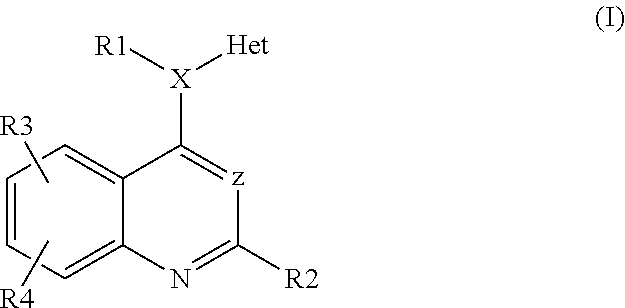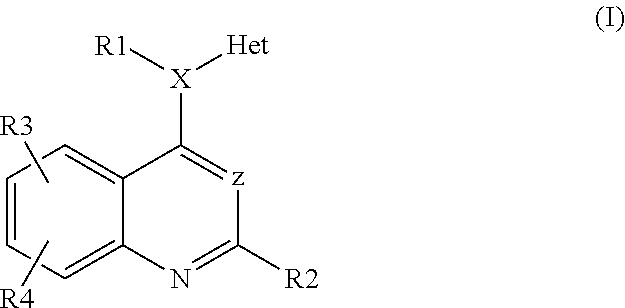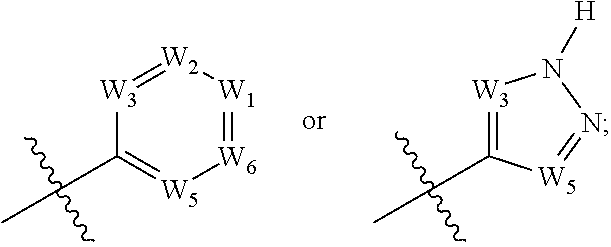Heteroarylaminoquinolines as tgf-beta receptor kinase inhibitors
a technology of tgfbeta receptor and heteroarylaminoquinoline, which is applied in the direction of chemical treatment enzyme inactivation, drug composition, cardiovascular disorder, etc., can solve the problems of increased risk, increased risk, and development of tumors with enhanced growth and invasiveness
- Summary
- Abstract
- Description
- Claims
- Application Information
AI Technical Summary
Benefits of technology
Problems solved by technology
Method used
Image
Examples
example 2
In-Vitro (Enzyme) Assay for Determination of the Efficacy of Inhibitors of the Inhibition of TGF-Beta-Mediated Effects
[0351]The kinase assay was carried out as 384-well flashplate assay. 31.2 nM of GST-ALK5, 439 nM of GST-SMAD2 and 3 mM of ATP (with 0.3 μCi of 33P-ATP / well) were incubated in a total volume of 35 μl (20 mM of HEPES, 10 mM of MgCl2, 5 mM of MnCl2, 1 mM of DTT, 0.1% of BSA, pH 7.4) without or with test substance (5-10 concentrations) at 30° C. for 45 min. The reaction was stopped using 25 μl of 200 mM EDTA solution, filtered with suction at room temperature after 30 min, and the wells were washed with 3 times 100 μl of 0.9% NaCl solution. Radioactivity was measured in the TopCount. The IC50 values were calculated using RS1. Above and below, all temperatures were indicated in ° C.
[0352]In the following examples, “conventional workup” means: water was added if necessary, the pH was adjusted, if necessary, to a value of between 2 and 10, depending on the constitution of t...
example 3
Synthesis of N-(2-Acetyl-phenyl)-5-chloro-2-fluoro-benzamide (M 291.71)
[0355]
70 g 2-amino acetophenone were reacted at ambient temperature in 2.5 I THF in presence of 177 ml N-ethyl diisopropylamine with 100 g 5-cloro-2-fluoro-benzoylchloride while temperature rose from 20 to 34° C. and white precipitate appeared. After one more night the suspension was filtered and the filtrate concentrated. Solution in THF at 80° C. was slowly diluted with water. After a night at ambient temperature precipitate was filtered and washed with water. After drying 149 g product was obtained as pinkish needles with Rt˜2.49 min and correct M+H+ 292 in LC-MS system 1.
example 4
Synthesis of 2-(5-Chloro-2-fluoro-phenyl)-1H-quinolin-4-one (M 273.70)
[0356]
[0357]148 g N-(2-Acetyl-phenyl)-5-chloro-2-fluoro-benzamide (cf. Example 3) suspended in 4 l tert.-BuOH were charge in several portions with 171 g KOBut. The red solution was heated for 20 hrs at 75° C. to become brownish. After concentrating to about 1 l the slurry was poured slowly to 5 l water / ice, the pH adjusted with concentrated HCl to 1-2 to produce a yellow slurry. After 30 min the precipitate was filtered and washed with water and 2-PrOH. The moist precipitate was digerated and refluxed with 3 l MTB ether. After filtration 96 g of product were obtained with M+H+ 274 in LC-MS system 1.
PUM
| Property | Measurement | Unit |
|---|---|---|
| Force | aaaaa | aaaaa |
| Molar density | aaaaa | aaaaa |
| Time | aaaaa | aaaaa |
Abstract
Description
Claims
Application Information
 Login to View More
Login to View More - R&D
- Intellectual Property
- Life Sciences
- Materials
- Tech Scout
- Unparalleled Data Quality
- Higher Quality Content
- 60% Fewer Hallucinations
Browse by: Latest US Patents, China's latest patents, Technical Efficacy Thesaurus, Application Domain, Technology Topic, Popular Technical Reports.
© 2025 PatSnap. All rights reserved.Legal|Privacy policy|Modern Slavery Act Transparency Statement|Sitemap|About US| Contact US: help@patsnap.com



